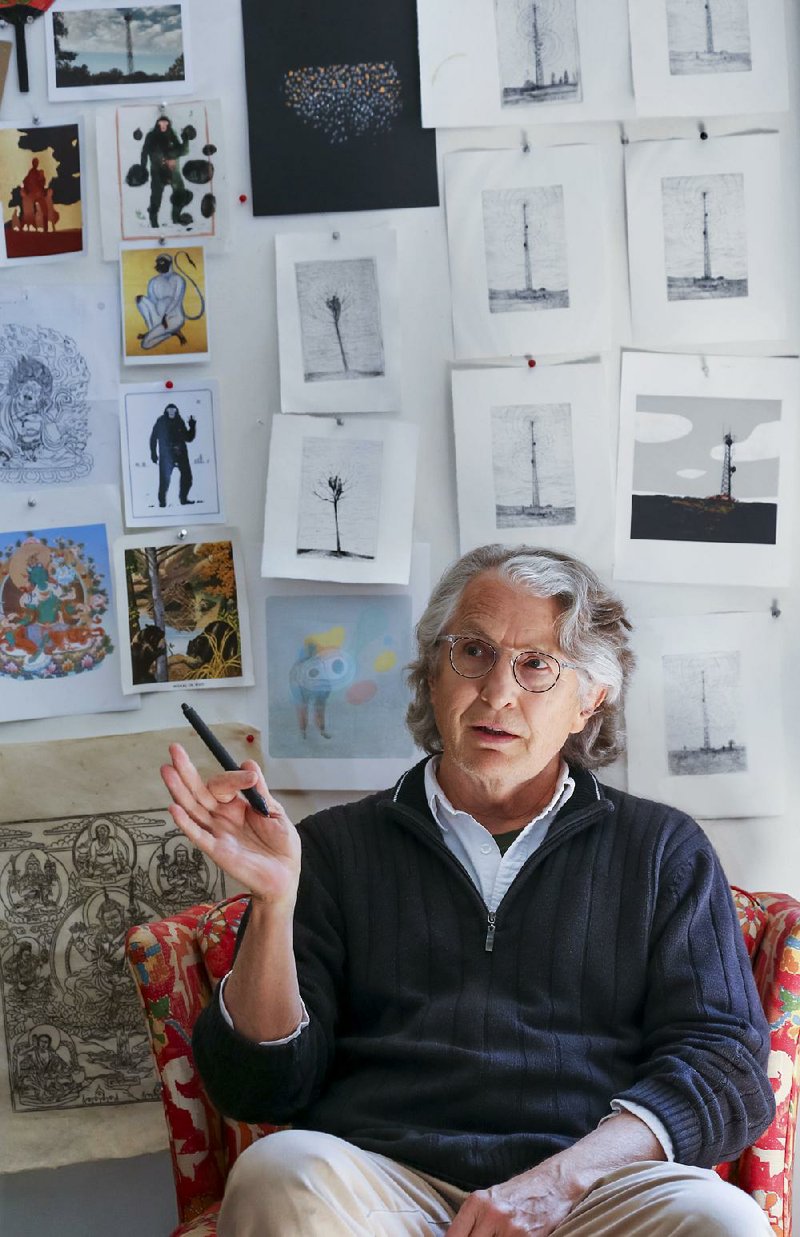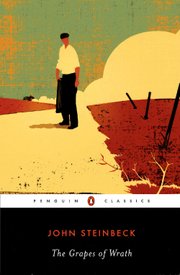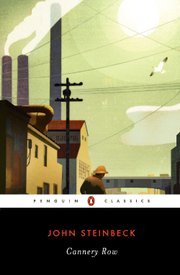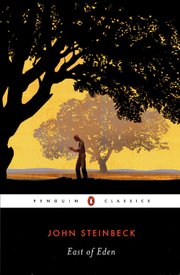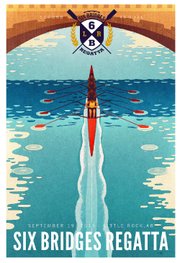Mick Wiggins has art in high places.
He's a digital illustrator whose four decades of work has graced magazines such as the Harvard Business Review, Smart Money and Arkansas Life as well as newspapers such as the Wall Street Journal, book covers, theater posters, print advertisements, clothing and special events.
Wiggins' work might be called elegant, streamlined, a bit stylized: characters with softened, gently etched, or no facial features; settings that present a preponderance of earth-tone hues, happily married to pops of bright color.
A perusal of Wiggins' online portfolio -- Mickwiggins.com -- reveals a bicyclist, clad in cobalt blue, bent intently over his machine as he pedals past the Eiffel Tower. A tall figure, his fist raised defiantly, on a playbill for the play My Children! My Africa! A woman gazing out over a lake on the cover of Nicola Upson's book Angel With Two Faces; out over a snowy landscape for Angela Thirkell's novel High Rising. A lone male figure behind the wheel of a retro-style car, rolling through the English countryside, in an advertisement for Badger Ales. Trains and trees and buildings and birds and boats and planes and puddles ... all executed with an aesthetic meant to draw in the eyes of the divergent masses.
"I think one of the things that just about every illustrator has in common is that we are part of the culture ... we are trading in commonly held symbols and metaphors and we're communicating with culture, and we're basically pretty soaked in culture," Wiggins says. "Most illustrators that I know are real omnivores. I can be executing my pictures in a very particular style, but I like everything."
For the past three years, his work has been the official art for the Arkansas Literary Festival, a multifaceted event hosted by the Central Arkansas Library System and held in April.
The art for this year's April 25-29 event offered as a commemorative poster is a hodgepodge of people -- authors, characters, themes/symbols -- spilling out of a book, labeled "2018," with the city's river and bridges in the background. It follows his 2016 festival image of an accordion-playing, bird-headed man standing on an open, upside-down book and his 2017 image of a flying, multicolored human figure.
ATTENTION TO DETAIL
It was Wiggins' work for the 2015 Six Bridges (Rowing) Regatta -- illustrated posters he signed -- that got the attention of Brad Mooy, Literary Festival coordinator.
"I just kind of fell in love with it," Mooy says of the regatta poster. "I searched to find out who designed that poster and I was thrilled to learn it was somebody that lived here in Little Rock ... His work is just amazing."
What does Mooy enjoy so much about Wiggins' images? "I think it's the sweet[ness] and a sense of yearning, and there's a hint of mystery and his use of color. And there's a radiance -- sort of an incredible use of panorama."
Mooy notes that Wiggins dedicated a lot of time to creating image details that are particular to this year's festival.
"While the overall sweep is beautiful, if you spend even more time with it and look at the individual elements ... many of those actually represent folks who [came] to the festival, or characters, or topics from the books that are represented in the event. So it's doubly creative ... When you really study it, it's doubly terrific."
PENCIL, PAINTBRUSH ... MOUSE
Wiggins, 65, has been in Little Rock since 2009. He and his wife, Cheryl, moved from California to be with their daughter Katie, who lives in Perryville and owns Farm Girl Meats, and their two granddaughters. The couple also have a son, Leo, who lives in New York.
It was in California that Wiggins' career began.
"I'd gone through a fine-arts program" -- at the University of South Florida in Tampa, where he graduated in 1975 -- and it was hardly what you would call a vocational education," Wiggins says. He moved to Martha's Vineyard where "basically, I washed dishes and cooked in restaurants for about two or three years and was a vagabond."
Ending up on the West Coast -- San Francisco -- Wiggins says, he decided he would have to "grow up and get a job." He found his way into the art department of a computer magazine -- PC Magazine: The Independent Guide to IBM-Standard Personal Computing -- that started up in 1982. He moved up through the ranks and eventually became art director at PCWorld, begun by PC Magazine co-founder David Brunnel after the sale of the latter.
"In '85 I just decided that office work wasn't my cup of tea, or my strength, and I left to become an illustrator," Wiggins says. Why an illustrator? "Because I was hiring them. And they were having a lot more fun than I was," Wiggins says.
But becoming a self-employed member of the profession was not particularly easy, he found.
"It looks kind of fun and lightweight, but actually it takes five to six years to really kind of build a career," he says. "I hung in there and I kept getting hired, which is the only feedback you get when you freelance."
Wiggins started out creating illustrations the old-school way ... painting and drawing them. When Macworld magazine began, he was asked to create illustrations for it via computer. He began making digital illustrations in 1983 and, being in the middle of the Silicon Valley boon, he gained a reputation. He continued doing some analog art, but by 1987, he was getting more calls for digital work. "The digital media kind of fit my own abilities somehow," Wiggins says, so he dropped the traditional media and became a digital artist.
"That said, it always, always, always, starts out as drawing and paper. And then those marks, those drawings, are put onto the computer and it's finished out on the computer."
NO EGOS HERE
Modest about his work, Wiggins says that illustrators are usually their own harshest critics. The jobs about which those in his profession are subject to especially get nervous, he says, are the jobs that will garner a lot of attention, have a big public presence.
One of the most memorable projects of his career came when he was hired to do a set of John Steinbeck book covers for Penguin Classics, a job he says was scary simply because of Steinbeck's prominence in American literature.
"You just know that those book covers are going to hang out for years on the bookshelves," he says. "If you do a work you think that doesn't reflect your strengths ... you don't really want to see it hanging around.
"But it all worked out well, and I'm really happy and relieved to say [that out of] about 27 covers, there's only but one or two clunkers in my eyes."
Wiggins says his influences are European poster artists from the early 20th century such as British railway illustrator Tom Purvis. Japanese wood cuts by artists dating to the 19th century figure prominently into his shapes and compositions. American painter Stuart Davis was also an influence.
"All of these used a graphic, naturalistic, yet reductive style of representation that emphasized color and composition, rather than realism," Wiggins says.
But "I don't think illustrators, including myself, really think of themselves, 'Oh, I'm a realist' or 'I'm a conceptualist,' " he says. "We just make pictures that fit the project.
"I've done things that are very, what you would call narrative storytelling -- standard book cover-looking, people looking at the ocean or something -- just basically cliches ... to very fragmented modernistic approaches." He cites his "mural-esque" illustrations for the United States Postal Service, illustrations that accompanied the release of a commemorative Mark Twain postage stamp (which itself was not his work) within a booklet. The works depicted scenes from Twain's books A Connecticut Yankee in King Arthur's Court; The Innocents Abroad, or The New Pilgrims' Progress; The Adventures of Tom Sawyer and The Adventures of Huckleberry Finn. The mural Wiggins did for Bed Bath & Beyond's flagship store in New York, on the other hand, "was such that it had to be fragmented and made much more [with] a modernistic feel to it.
"I'm more more interested in solving the problem for the client and making it work for them than fulfilling some kind of aesthetic creed of my own."
HARD WORK
Wiggins refers to illustration as "surprisingly" hard work.
"It's pretty lonely and you're by yourself a lot and you're your own harshest judge and you have deadlines. It's not for everyone."
The length of time it takes Wiggins to create an illustration depends on the job, its completion process and the client's deadline ... from 24 hours -- "if you're lucky" -- for a newspaper illustration; a week or two for a magazine illustration; one to three weeks for a book cover. Rates being what they are, an illustrator often must work on multiple jobs simultaneously. Rates for illustrators have been flat for about 30 years, Wiggins says, and illustrators generally try to find a way to streamline tasks so they can pay the bills.
Soon to retire, Wiggins, who also teaches illustration at the University of Arkansas at Little Rock twice a week, is currently working on a third children's picture book for Simon and Schuster. "In the meantime, I like to do things, and I will keep doing things, that I like a lot" -- locally based work for entities he supports, such as the Literary Festival. He has completed eight stamps for the Postal Service, due to be released sometime this year and next.
Wiggins does see his profession continuing. "I just hope that it pays," he says.
A young, 21st-century illustrator must not only be talented, he says, but be willing to offer diversified services in order to get enough work. What with magazines and newspapers going online, illustration's got to start moving, he says ... literally. Animated illustration is becoming a thing -- "a value-added experience for readers."
The bottom line in entering the profession, Wiggins adds, comes with the answers to these questions: "Can you stand the rhythm and the demands of the job, that is, the collaboration, the willing to take direction, the willingness to make changes to something you find precious [but that a client wants changed]?
"You can die literally a thousand little deaths ... but you get over yourself."
Style on 05/13/2018
